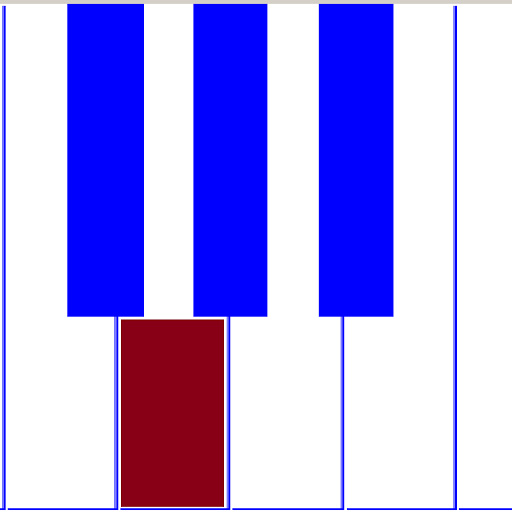

"Garden of Earthly Delights" is
The opening track on an album (self-titled) by a group called Arzachel *
* This band was originally called Uriel, and consisted of Steve Hillage on guitar, as well as the three members of the future-named Egg. For contractual reasons, this single album was recorded under the unique name of Arzachel. I am pretty sure that bassist Mont Campbell wrote this composition/song.
Starts with E Major.
Right hand organ plays (lowered 7th degree)
D_natural
Can be thought of, therefore, as E-Mixolydian (which is like Major, but with lowered-7th)
D, B, C#
A, B
G#, F#, E
Then, transitions to the next harmony via a suspension:
E sus4 ('A' is P4th above 'E') , which then lowers a semi-tone down to G# (which is Major-3rd above 'E').
Esus4, to E Major
sorry, instead of 'A' to 'G#', 'tis:
F# to G# , with E as root , all along.
(Bsus4 / Esus2) to E Major.
Ah, yes, (instead of 'A', F#, leading to G#) anticipates the 3rd of the next chord, which is:
THEN
--------------------------------
down to
D Major chord (triad).
Simply move the the third (3rd) of that chord, up , and down (diatonically , not chromatically)
F#, to G, back to
F#, to E
like folk-rock guitar
Well, I hear :
D (I) to G Major (IV)
D (I) to Asus4, ?
Next passage features Steve Hillage doing a shrill very English-sounding lead vocal:
F Maj. C Maj.
E-flat Maj. , B-flat Major
Notice how the root (pitches) of each pair of chords are a P4th apart.
and the two sequences are off-set by a whole-step / Major-2nd , apart from one another.
Then back to verse with D Major.
A juicy chord :
Juicy chord
There is more than one way of looking at this juicy chord:
The root in left hand ('A') is off-set by one whole-step (M2nd) from the root of the right hand chord:
G Major (7).
You can identify a pentatonic tone cluster (pitch cluster) in that:
A+B + D+E+ F#
(+ G )
or, G+A+B + D+E
Also, more formally, known as the A13sus(4) chord (or A 13 sus 2).
Forget the pentatonic way of examining this chord.
Instead, understand it as (in terms of):
A5 (A+E) in left hand
+
G Maj. 7 , which is ___
the "III7" of dorian mode in 'E' (which is a P5th above (and P4th below) the root of the left hand.
e dorian's
i7 is : e min. 7
ii7 is : f# min. 7
III7 is : G Maj. 7
Mike Ratledge (who was an influence of/on , at least the keyboard player Dave Stewart) used this type of chord/harmony on two of his own Soft Machine compositions:
"Pig" (which is the first movement of "Esther's Nose Job" suite from Volume 2 (1969) ) , as well as "Slightly All the Time" (albeit, in a different key/tonal-center : C5 + B-flat5 Maj.7) , the next year (1970).
"dorian 3 chords root P5th below"
http://SaveDeo.com/download?url=http://youtube.com/watch?v=fO-9B8bcMBk
That lesson features invertin a minor-7th chord to make a Major-6th chord.
and the A5 + G Maj.
That chord relates to , a same/similar chord in "September" by Earth, Wind, and Fire.
__________
last / ending passage:
b-flat minor 7
to
B7#11
Steve Hillage solos (improvises?) over those two chords using the
"b-flat" blues scale
(minor-pentatonic with an additional chromatic pitch, or two like the Tri-Tone (between the 4th and 5th degrees) ) .
related: opening chord of "Pataphysical Introduction" by Robert Wyatt (appeared on The Soft Machine's second LP, Volume 2 (1969) :
see Slide #197
https://docs.google.com/presentation/d/1QU4V3ncxld0IZzDJ18rUxm6jjAJ5ZG8JDi51bsivVpM/view#slide=id.g10bf66dd64_0_1521
G(5) + F Maj. 7
move that up a whole-step (in parallel) and you have the "Juicy chord" in Arzachel ("Garden of Earthly Delights")
Both of those chords (one-whole step apart) ,
A5 + G Maj.7
and
G5 + F Maj.7
are first two chords in chord cycle of "As Long as He Lies Perfectly Still"
Another connection, with another composition, by another band:
Dedalus - opening track of their self-titled debut LP (album, 1973) "Santiago"
Root pitches (harmonic roots) (left hand / bass) are : B , to G (a Major-3rd apart)
I can't figure out what exact voicings keyboard player Fiorenzo Bonansone is playing, but what sounds like a harmonic approximation and match is:
Major-seventh chords whose roots are one whole-step lower than the left hand bass pitches, at bottom --
In the case of this particular piece of music, that means:
B(5?) + A Maj. 7
down to
G(5?) + F Maj. 7 <---
One additional note
B(5?) + A Maj. 7
add : a quartal chord (B sus4, inverted) : F#-B-E
The electric piano plays a number of such quartal (stacking 4ths) voicings, throughout.
regarding the 2nd harmony (root of 'G') ,
all 3 of the "i7" , "ii7" , and "III7" chords of the dorian mode that is rooted on the P5th above (P4th below) work, in fact:
G in bass + d min.7 , e min.7 , and F Maj. 7 in right hand.
See how the F Maj. is the "III7" of the d dorian mode ?
One more chord (harmonic) connection -- with "Azrael" (similar name, eh?)
The first song that Keith Emerson wrote with bassist (and vocalist) Lee Jackson of The Nice (back in 1967?) -- uses this type of chord:
F + E-flat Major
then, modulate a minor-third (m3) up to:
A-flat + G-flat Major
Download video that I made that illustrates the harmonic structure (chord progressions) of/in that song:
http://SaveDeo.com/download?url=http://www.youtube.com/watch?v=V8CUWvAgVKs
back to Free Instructional Materials
| back to homepage |